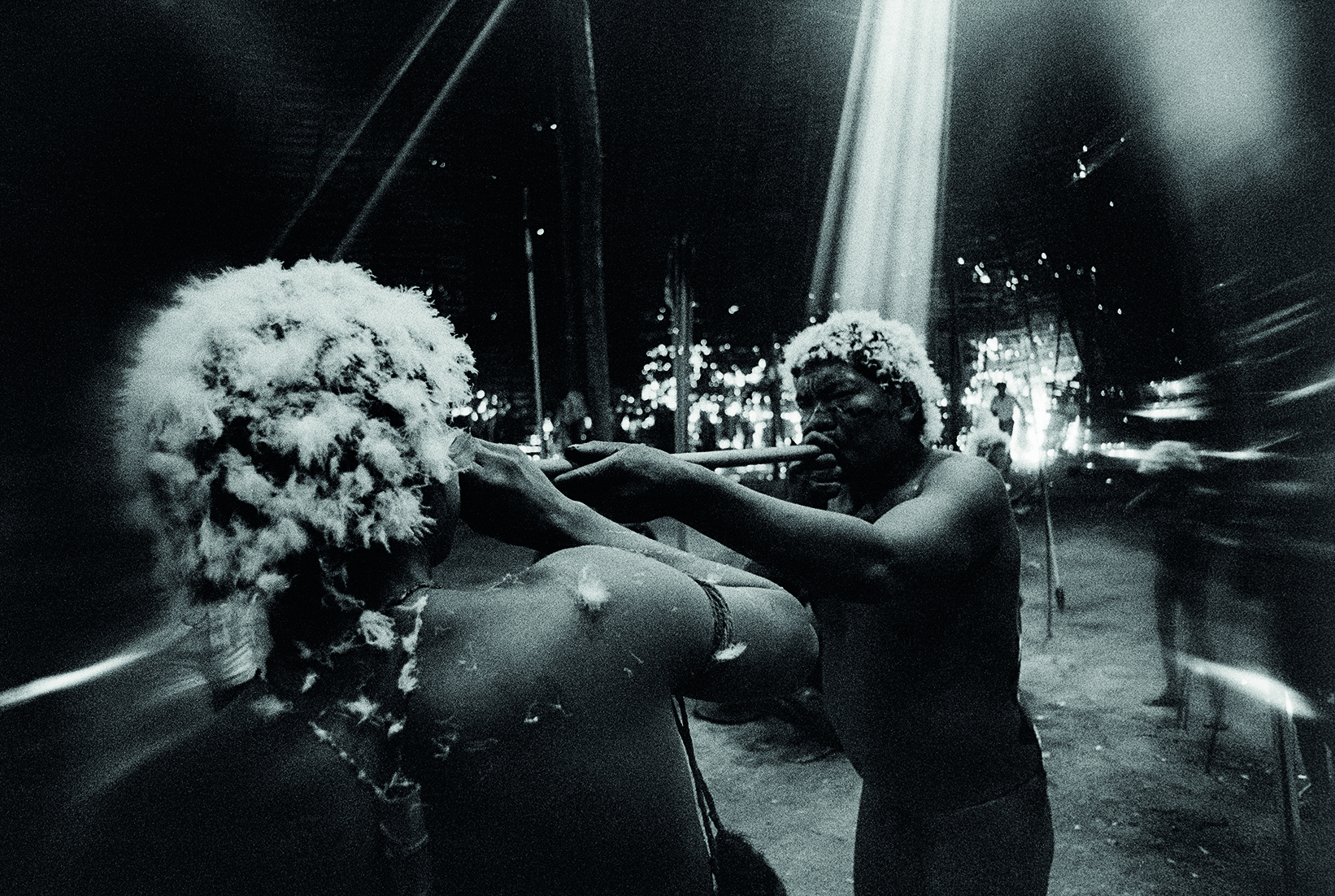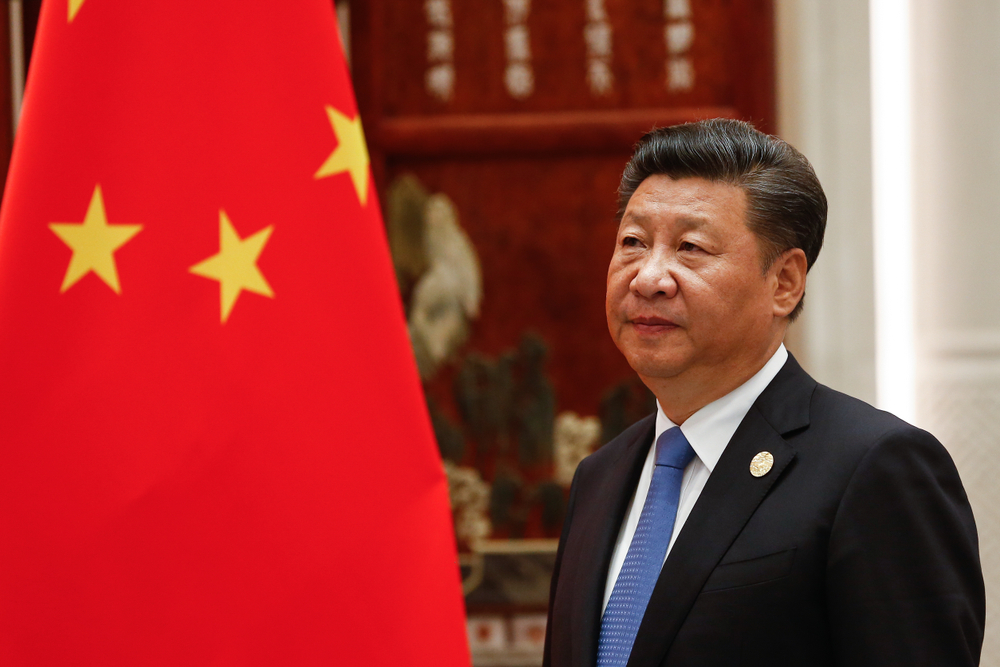Photographs of Amazon Tribe at Museum of Ethnography

The shaman and tuxaua João administers the hallucinogenic yãkoan (from the Reahu series) Catrimani, 1974 / Photochemical print.
The press release for the Museum of Ethnography’s exhibition of Claudia Andujar’s work describes her as a “Hungarian-origin female photographer.” In fact, the experience of being Hungarian Jewish is central to Andujar’s work, although it may not look that way at first.
Now housed in a truly remarkable new building, the Museum of Ethnography in Budapest has existed for 151 years.
Judit Gellér (one of the curators of the Andujar exhibition “Yanomami. Spirits. Survivors.”) tells me the institution is “a social museum dedicating exhibitions to generate discussions about social issues on the one hand and, on the other, to show the collection the museum has accumulated since it was established. All our exhibitions have an international, multicultural, ethnographic aspect, but some are devoted to the Hungarian cultural ethnographical heritage,” she explains.
Her co-curaters are Borka Eszter Bazsó, Magdolna Szabó and György Szelja.
Held in collaboration with São Paulo’s Vermelho Gallery, “Yanomami. Spirits. Survivors.” is the first contemporary photo exhibition in the new building. Unfortunately, Andujar, 92, is not well enough to travel to Hungary.
She was born in 1931 in Nagyvárad (modern-day Oradea, Romania) to a Swiss mother and a Hungarian Jewish father. Towards the end of World War II, Andujar and her mother fled the Holocaust, escaping to Switzerland. Her father died in Dachau.
She then moved to New York, where she studied humanities at the prestigious Hunter College in New York City. In 1949, she married Spanish refugee Julio Andujar. From the 1950s onwards, she became associated with the contemporary art and photography scene. In 1956, she moved to Brazil to be with her mother.
Andujar’s career in photojournalism began with a project on the Karajá people of Central Brazil. Since then, her work has appeared in magazines such as Life, Aperture, and Realidade. She received Guggenheim Fellowships in 1971 and 1977.
Communication Tool
In her photographic work, Andujar wasn’t especially influenced by great Hungarian photographers such as Capa or Brassai. As Gellér told me, “She didn’t know these artists personally. She took up photography in Brazil purely as a tool to communicate. It was there that she met photographers and anthropologists, and her photography began to develop.
According to Thyago Nogueira, head of Contemporary Photography at the Instituto Moreira Salles in Brazil, “In the first half of [Andujar’s] life, she was searching for photographic representation of something that was immaterial, that was abstract; of a people and a culture, and of a way of seeing the world that she wanted to give a photographic form to.”
She first encountered the Yanomami, who live in the Amazon rainforest, in the early 1970s, became fascinated by them and their philosophy and found her subject. More than that, “They quickly became a second family to me,” she has said.
Her work to help protect the Yanomami began then. It took time for them to become comfortable being represented visually by photography. One of the ways Andujar convinced them to accept it was by explaining that it could help protect them from the violence of the outside world.
When, in the 1970s, the Brazilian government started planning to build a transcontinental highway through the Amazon, it began to look like the Yanomami way of life would be wiped out. Having been forced to flee Hungary by the Nazis as they attempted to destroy Jewish culture and knowing her father and members had been killed in the genocide, Andujar felt compelled to act.
In 1977, she denounced the appropriation of indigenous land by settlers and was expelled from the region by the Brazilian military regime.
Throughout the 1980s and ’90s, when the Yanomami were being killed by disease and poisoning resulting from the intrusion of the outside world, Andujar was their champion. She was one of the driving forces that led to the Brazilian government establishing a 96,000 square kilometer (37,000 square mile) protected area for the Yanomami in 1992.
Photographic Activist
Andujar documented the Yanomami culture in her book “Yanomami: The House, The Forest, The Invisible” published in 1998.
“Yanomami. Spirits. Survivors.” presents 124 photographs, analog enlargements, digital prints and additional projected imagery that showcase a significant portion of Andujar’s life’s work. The exhibition is structured chronologically from when she arrived in Brazil through her career as a magazine photographer to her work as an activist.
Her work generally doesn’t present itself as supposedly objective reportage of “the other.” As the Museum of Ethnography points out, “Andujar’s primary goal is not to document ethnographic phenomena; rather, her photographs reveal a personal narrative about her own journey and her dialog with the Yanomami people.”
But it’s a journey that embodies the themes of cultural encounter, discovery, understanding and representation that are at the heart of anthropology.
Driven by her sense that she’d found a second family and because her work is characterized by, as the museum puts it, “a unique and sensuous perspective often found in female artists,” Andujar takes a far less conventional and much more exciting approach.
In her first photos of the Yanomami, she decided she wanted to try and show something of their vision of the Amazon around them and their spirit world. Using techniques such as flash devices, infrared film and Vaseline on her lens, she made photographs that were distorted and strange but intriguing.
Somehow, the photographs taken by Andujar and curated by Gellér are all the more powerful for not being straightforward reportage. They’re even more of an activist tool to save the Yanomami and the Amazon itself because they attempt to convey the spiritual richness of the people and the place.
“Yanomami. Spirits. Survivors.” runs until June 2024. An exhibition of Korean costumes and clothing opens in late October. In spring 2024, the Museum of Ethnography will open a large permanent exhibition showing its collection and explaining its processes. Find out more at www.neprejaz.hu.
This article was first published in the Budapest Business Journal print issue of October 20, 2023.
SUPPORT THE BUDAPEST BUSINESS JOURNAL
Producing journalism that is worthy of the name is a costly business. For 27 years, the publishers, editors and reporters of the Budapest Business Journal have striven to bring you business news that works, information that you can trust, that is factual, accurate and presented without fear or favor.
Newspaper organizations across the globe have struggled to find a business model that allows them to continue to excel, without compromising their ability to perform. Most recently, some have experimented with the idea of involving their most important stakeholders, their readers.
We would like to offer that same opportunity to our readers. We would like to invite you to help us deliver the quality business journalism you require. Hit our Support the BBJ button and you can choose the how much and how often you send us your contributions.










